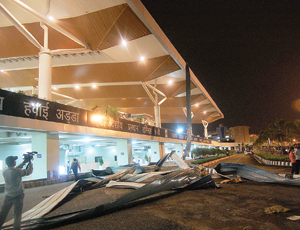An investigation has been launched into why 1,000 sq m of roof was blown off Indira Gandhi International Airport’s six-month-old domestic terminal during a storm on Aug. 21 that had winds of over 90 kilometers per hour lasting 10 minutes. The section comprised about 5% of the 20,000 sq m high-tensile steel roof on the $100-million terminal.

Delhi International Airport Ltd. (DIAL), the concessionaire that holds a contract to develop, manage and operate the airport, has formed a team to look into whether there could have been a mishandling of the project in specific areas of design, implementation, workmanship, materials and testing, says a senior government aviation official.
DIAL is a joint-venture consortium of GMR Group, Airports Authority of India, Fraport and Eraman Malaysia. It hired contractor B.L. Kashyap to build the terminal, Tata Consulting Engineers to act as project management and quality-control consultant and Tata BlueScope Steel Ltd. to supply and install the roof.
One aviation analyst suggests that the roof was designed to “take down forces, not uplift, and so part of it got pulled up, creating a hole and letting the rainwater in.” But the architect, Mumbai-based Hafeez Contractor, whose firm bears his name, refutes this, saying the roof was designed for both uplift and top load. The roof, consisting of concealed fixed cladding with rock-wool insulation, was designed to code, Contractor adds, calling the event a “freak incident.”
The roof system, called Klip Lock, is manufactured from high-tensile steel sheets coated with zinc and aluminum and sold under Tata BlueScope’s brand ZINCALUME steel. “The coils are from Australia, and the profiling is done in Pune, India,” says Contractor.
“There was nothing wrong with the roof design,” says an engineer who did not want to be named. He blames the “tornado-effect” winds. “When you have a natural calamity, it could have come off after 50 years. Unfortunately, it came off in five months,” he says.
The roof cladding combines fluted pans and a lock-action rib design with concealed fastening. “[It] could be the roof fell because the fasteners were not fixed right, ” says another engineer.
The system is designed to control thermal expansion and contraction. Two longitudinal stiffeners between ribs gives it a strong profile. The cladding is fixed on a specially designed clip that does not pierce the roof sheeting.

Post a comment to this article
Report Abusive Comment